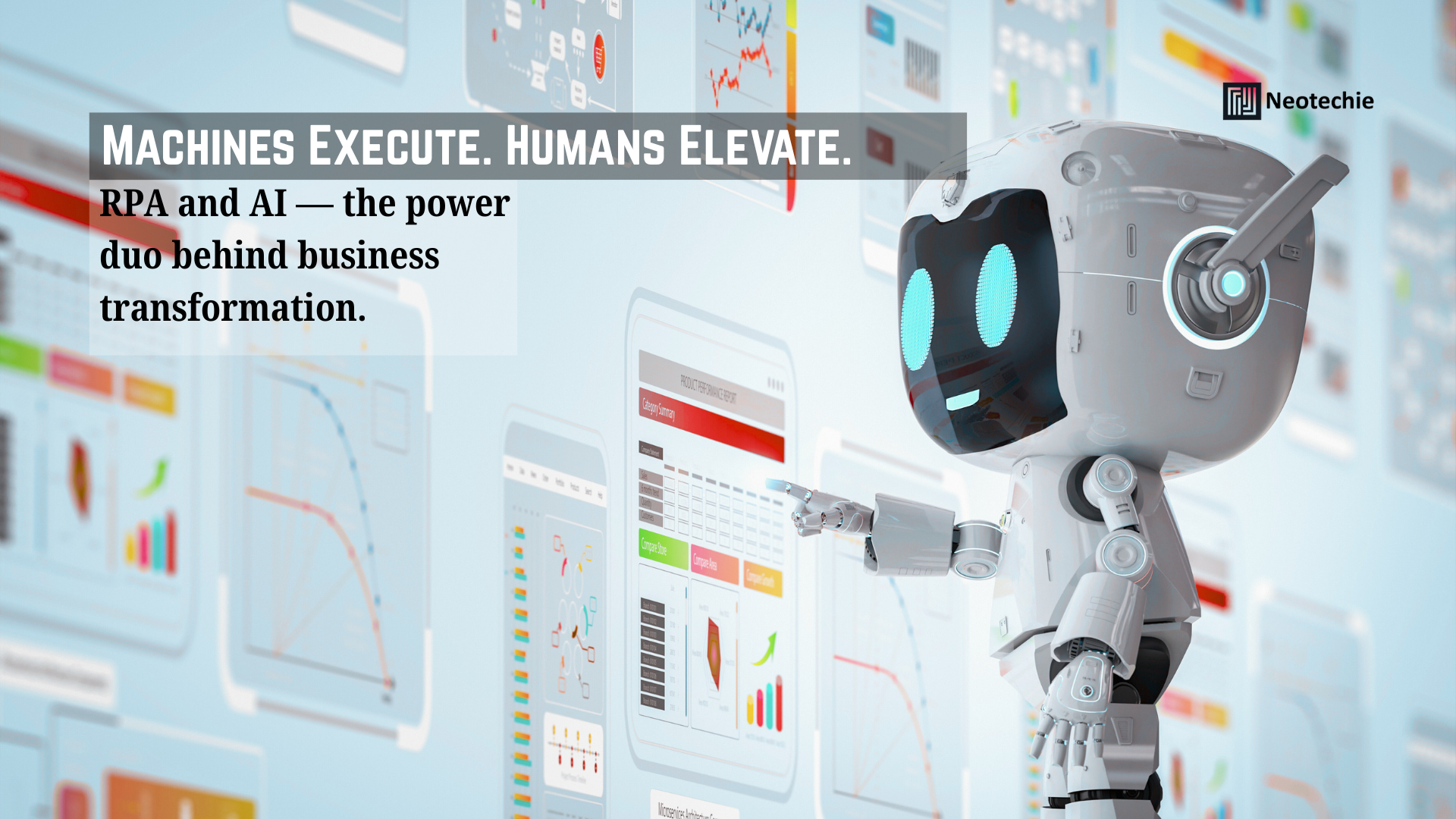Human + Bots: How the Future of Work Looks with AI-Driven Automation
A software bot finishes your reports before your morning coffee. An AI system books meetings, filters your emails, and predicts next quarter’s business risks. Your role? To think, create, and lead. This is not a sci-fi pitch. It’s the near-future reality shaped by Robotic Process Automation (RPA) and Artificial Intelligence (AI).
We’re entering an era where bots aren’t taking jobs away—they’re transforming them. AI-powered automation is becoming the silent coworker, handling repetitive tasks with unmatched efficiency. RPA bots automate rule-based workflows, while AI provides adaptability, intelligence, and decision-making capabilities that elevate business operations and drive transformation.
RPA and AI: The Automation Power Duo
Robotic Process Automation handles high-volume, repetitive tasks: think invoice processing, data migration, and compliance checks. It mimics human actions but executes them faster, without breaks, and with near-zero error. When RPA is paired with Artificial Intelligence, it becomes Intelligent Automation—a game-changer for business transformation.
AI introduces reasoning, context, and learning capabilities. It allows bots to extract data from unstructured documents, understand customer sentiment, and even make recommendations based on patterns. Together, RPA and AI streamline workflows, reduce costs, and enhance customer and employee experiences.
Industries like healthcare, finance, retail, and manufacturing are witnessing major productivity and efficiency gains thanks to this powerful combination.
Business Transformation Through Automation
This isn’t about replacing workers—it’s about redefining how work gets done. Businesses leveraging RPA and AI are:
- Cutting operational costs by automating back-office tasks
- Increasing accuracy and compliance with fewer manual errors
- Enhancing customer experiences with faster and smarter service
- Freeing up human employees to focus on strategic initiatives
In finance, bots reconcile accounts overnight while AI models flag anomalies. In logistics, AI predicts delivery delays and RPA triggers automated updates. In customer service, chatbots resolve queries instantly, routing only complex issues to humans. This is real, measurable transformation.
The New Roles in a Digitally Transformed Workforce
Automation doesn’t eliminate jobs—it changes them. As businesses embrace AI and RPA, new roles emerge:
- Automation Strategist: Designs long-term automation roadmaps
- AI Business Analyst: Aligns AI capabilities with operational needs
- RPA Developer: Builds and maintains automation bots
- Process Architect: Optimizes workflows for digital execution
To succeed in this era, professionals must develop digital fluency and understand how to collaborate with intelligent systems.
Real-World Impacts of RPA and AI in Business
1. Financial Services
Banks use RPA to handle loan processing, KYC validation, and compliance reporting. AI systems assess credit risk and detect fraud in real-time, allowing faster, more accurate decision-making.
2. Healthcare
RPA automates patient registration, claims processing, and lab data entry. AI helps in diagnostics, assisting clinicians with faster and more accurate insights.
3. Retail & E-Commerce
Automation streamlines inventory updates, order management, and returns. AI improves customer targeting, personalization, and sales forecasting—delivering end-to-end operational efficiency.
Data and Intelligence as Drivers of Change
For RPA and AI to succeed, organizations must treat data as a strategic asset. Clean, well-structured data is the foundation for intelligent decision-making. AI thrives on context-rich information, and RPA depends on process stability. Together, they convert data into business value, guiding strategic choices and powering predictive operations.
The Human Edge in an Automated World
As bots handle execution, human workers take on new importance in roles that require:
- Problem-solving
- Decision-making
- Emotional intelligence
- Change leadership
- Innovation
The most future-ready organizations are those that invest in reskilling and foster human-machine collaboration.
Overcoming Challenges in Automation Adoption
While RPA and AI offer tremendous potential, common roadblocks include:
- Integration with legacy systems
- Skill gaps in automation technologies
- Data governance and AI transparency
Successful business transformation requires a clear vision, cross-functional collaboration, and strong leadership. Early adopters gain a significant competitive edge.
Looking Ahead: The Future Is Automated and Agile
The future of work is not man vs. machine—it’s man with machine. RPA and AI are not optional—they are essential tools for driving agility, resilience, and growth in the digital economy.
Companies that embrace automation-first strategies will reduce operational drag, improve experiences, and unlock new business models. The question isn’t whether to automate, but how fast and how smartly you do it.
This is the foundation of long-term business transformation—and it’s happening now.
Neotechie’s Role in RPA and AI Enablement
Neotechie is at the forefront of helping organizations navigate the shift toward intelligent automation. By focusing on practical, business-ready solutions in Robotic Process Automation and Artificial Intelligence, Neotechie empowers teams to streamline operations and scale efficiently.
Whether it’s building resilient RPA frameworks or embedding AI into customer workflows, Neotechie offers hands-on guidance tailored to business transformation goals. From consulting and development to implementation and training, Neotechie ensures that automation is not just integrated—but optimized.
By combining technology expertise with strategic insight, Neotechie helps businesses unlock the full potential of RPA and AI to stay competitive and future-ready.

